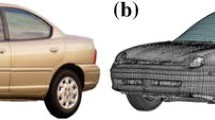Abstract
Full-vehicle finite element models have a large number of degrees of freedom. This makes them ill suited for design work, numerical optimization or stochastic analyses in an early development phase, because they require a high level of detailed information, most of which is yet unavailable. They are also computationally expensive, thus severely limiting the number of function evaluations. Both difficulties can be alleviated through the use of substitute models, which capture only the relevant mechanisms, associated with a smaller number of degrees of freedom. This work provides a substitute modeling and calibration methodology which improves output value prediction for substantial deviations from the reference design, including three significant innovations. First, a new measure to quantify the agreement of calibrated and reference model is proposed. Second, a multi-model calibration is introduced, which incorporates an array of reference models for calibration and cross validation. Third, the calibration is performed on the basis of a hybrid objective function, weighting the agreement of the time dependent system states, called physics-based contribution, and the time independent output values, called predictive or regression-based. This ensures a large range of validity while simultaneously improving the predictive quality of the model. It is also shown that the discretization of the structural mass has negligible influence on the target values, allowing for reduced model complexity.
















Similar content being viewed by others
References
Carvalho M, Ambrosio J, Eberhard P (2011) Identification of validated multibody vehicle models for crash analysis using a hybrid optimization procedure. Struct Multidiscip Optim 44(1):85–97. doi:10.1007/s00158-010-0590-y
Cornette D, Thirion JL, Bos F, Dittlo M, Lorriliere F, Drazetic P, Markiewicz E, Payen F (1997) Plastic hinge concept for simplified vehicle crash simulation. Automotive Automation Limited, England
Duddeck F (2008) Multidisciplinary optimization of car bodies. Struct Multidiscip Optim 35:375–389
Halgrin J, Haugou G, Markiewicz E (2008) Integrated simplified crash modelling approach dedicated to pre-design stage: evaluation on a front car part. Int J Veh Saf 3(1):91–115
Hollowell WT (1986) Adaptive time domain, constrained system identification of nonlinear structures. University of Virginia, Charlotessville, USA. http://books.google.de/books?id=Ds3gNwAACAAJ
Huang M (2002) Vehicle Crash Mechanics. CRC Press LLC, Boca Raton
Ingber L (1996) Adaptive simulated annealing (asa): Lessons learned. Lester Ingber Papers 96as, Lester Ingber. http://ideas.repec.org/p/lei/ingber/96as.html
Kamal MM (1970) Analysis and simulation of vehicle to barrier impact. SAE paper 700414
Kerstan H, Bartelheimer W (2011) Innovative Prozesse und Methoden in der Funktionsauslegung - Auslegung fuer den Frontcrash. VDI-Berichte 2078:185–196
Kim C, Arora J (2001) Nonlinear dynamic system identification for automotive crash using optimization: a review. Struct Multidiscip Optim 25(1):2–18. doi:10.1007/s00158-002-0267-2
Kim C, Mijar A, Arora J (2001) Development of simplified models for design and optimization of automotive structures for crashworthiness. Struct Multidiscip Optim 22(4):307–321. doi:10.1007/PL00013285
Lehar M, Zimmermann M (2011) An inexpensive estimate of failure probability for high-dimensional systems with uncertainty (Struct Saf (2011) doi:10.1016/j.strusafe.2011.10.001)
Markiewicz E, Marchand M, Ducrocq P (2001) Evaluation of different simplified crash models: application to the under-frame of a railway driver’s cab. Inderscience Publishers
National Highway Traffic Safety Administration (2005) Office of vehicle safety compliance, room 6111, NVS-220, 400 Seventh Street, SW Washington, DC 20590: TP208-13 laboratory test procedure
Nikravesh PE, Chung IS, Benedict RL (1983) Plastic hinge approach to vehicle simulation using a plastic hinge technique. Comput Struct 16:395–400
Pereira M, Ambrósio J (1997) Crashworthiness analysis and design using rigid-flexible multibody dynamics with application to train vehicles. Int J Numer Methods Eng 40(4):655–687
Sousa L, Verssimo P, Ambrósio J (2008) Development of generic multibody road vehicle models for crashworthiness. Multibody Syst Dynamics
Storn R, Price K (2013) Differential evolution homepage. http://www1.icsi.berkeley.edu/storn/code.html
Storn R, Price K (1997) Differential evolution - a simple and efficient heuristic for global optimization over continuous spaces. J Glob Optim 11:341–359
Wiegers KE (2003) Software Requirements. Microsoft Press, Redmond
Author information
Authors and Affiliations
Corresponding author
Rights and permissions
About this article
Cite this article
Fender, J., Duddeck, F. & Zimmermann, M. On the calibration of simplified vehicle crash models. Struct Multidisc Optim 49, 455–469 (2014). https://doi.org/10.1007/s00158-013-0977-7
Received:
Revised:
Accepted:
Published:
Issue Date:
DOI: https://doi.org/10.1007/s00158-013-0977-7




